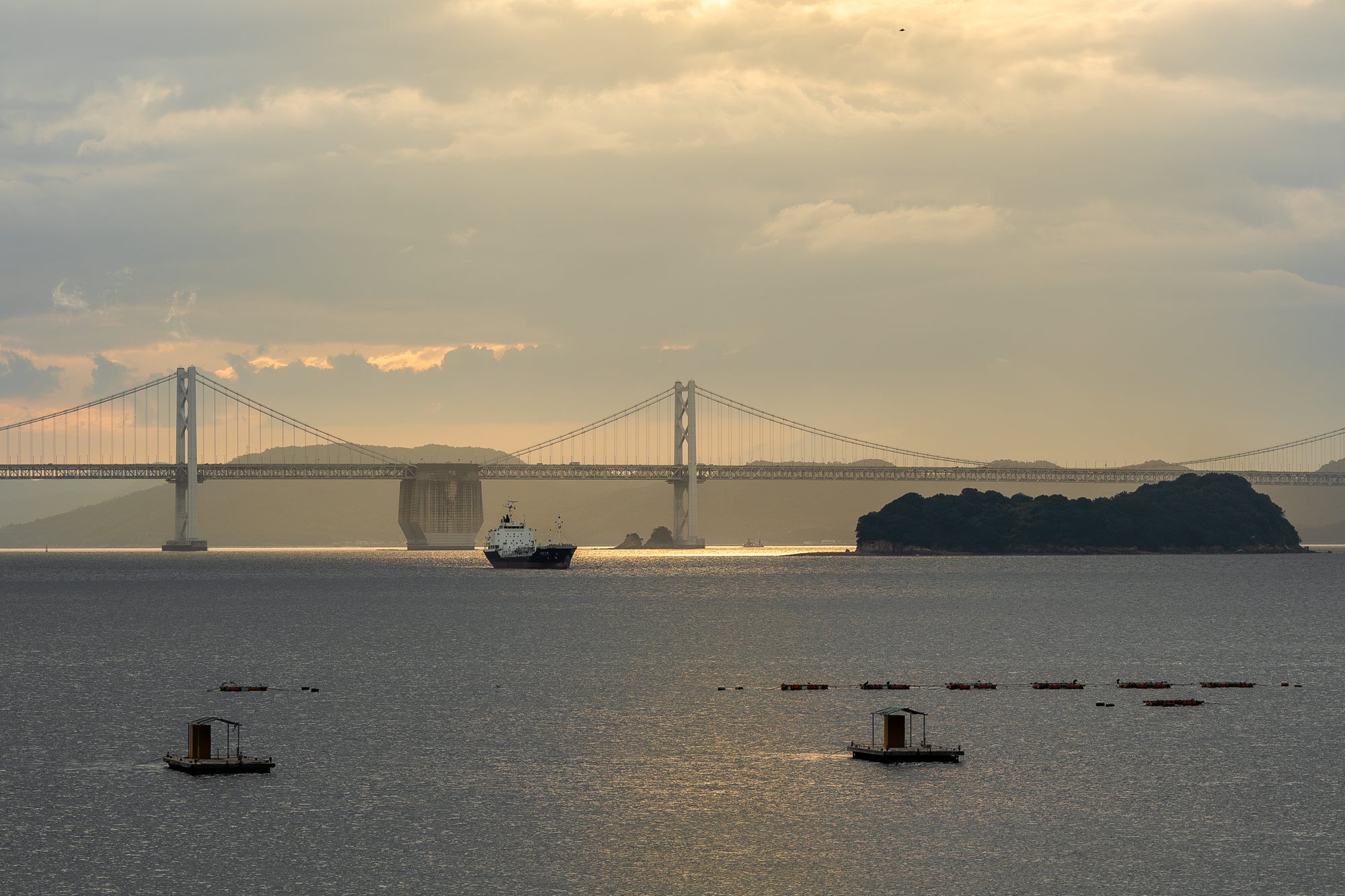
Exploring the Scent of Seto Inland Sea's Landscape and the Art of Cross-Sensory Perception / 瀬戸内海の香りと風景
The Seto Inland Sea stands as a true haven within Japan's natural beauty, offering breathtaking views and a diverse natural landscape that captivates many. Yet, the experience it provides goes beyond mere visual beauty—it extends to the realm of scent. The scent of Seto Inland Sea is an integral part of the region's distinct charm, adding another layer of sensory depth to its allure.
The Scent and Landscape of Seto Inland Sea: Immersed in Nature's Beauty
The Seto Inland Sea is adorned with azure waters and picturesque islands, resembling a canvas painted by nature's hand. However, its appeal isn't limited to sight alone; it also beckons to the sense of smell. The sea breeze carries with it a gentle scent of the ocean, subtly infused with the essence of salt. This delicate interplay of sea and land creates a moment that's unique to the Seto Inland Sea. The fusion of landscape and fragrance becomes an inseparable memory etched into our hearts.
Transforming Landscapes into Fragrances: Exploring the Intersection of Senses
The concept of translating landscapes into fragrances is a fascinating endeavor that delves into the intersections of senses, blurring boundaries between the perceptible. This idea resonates with synaesthesia, a phenomenon where one sense triggers another in an experience unlike any other. Attempting to convert landscapes into scents offers a novel pathway, inviting individuals to explore a crossroads of vision and olfaction.
Several approaches can be taken to convert landscapes into fragrances:
-
Investigating and Analyzing Smell: Each landscape incorporates diverse elements—plants, soil, water bodies, and temperature. Analyzing these components and identifying the scents and aromatic compounds associated with each can recreate the scent of the landscape. For instance, a forest landscape might be linked with the scent of pine or cedar.
-
Synthesizing Fragrances: It's possible to synthesize fragrances inspired by specific landscapes by combining natural aromatic compounds or synthetic fragrances. This approach captures the essence of certain landscapes, such as the scent of flowers or the sea, by encapsulating their character in fragrance.
-
Fusing Memory and Imagination: Landscapes are imprinted in our memories. By conjuring up a mental image of a landscape and imagining scents associated with it, attempts are made to reconstruct the landscape's essence as fragrance. This method bridges personal emotions and memories to the experience.
The Possibilities of New Sensory Experiences
Converting landscapes into fragrances unveils new dimensions in sensory experiences. Experiencing the beauty of landscapes through both vision and smell enriches our senses. Moreover, scents are intricately linked with emotions and memories, and the scents derived from landscapes might evoke past memories or emotions, creating a multisensory journey.
However, it's crucial to remember that transforming landscapes into fragrances is subjective, and each person's perception could yield unique experiences. This art form enables us to traverse our senses, embarking on a journey of creativity and sensory exploration.
In conclusion, the beauty of places like the Seto Inland Sea goes beyond visual appreciation; it can also be sensed through our olfactory senses. Likewise, the transformation of landscapes into fragrances taps into our senses from an innovative perspective. As we move forward, this exploration of merging landscapes with fragrances is likely to continue evolving, offering us new avenues to engage with and appreciate our environment.
風景を香りに変換するというアイディアは、感覚を交差させる面白いアートやサイエンスの一環として研究がなされているようです。
これはシナステジア(synaesthesia)と呼ばれる現象に関連しており、一つの感覚が他の感覚を刺激することによって生じる異なる感覚体験です。風景を香りに変換する試みは、人々に新たな視覚と嗅覚の交差点を提供することができるかもしれません。
こうした風景から香りへの変換は、いくつかの方法でアプローチされる可能性があります。
1. 嗅覚の調査と分析: 特定の風景には、地域の植物、土壌、水、気温などが関与しています。これらの要素を分析し、それぞれの要素が持つ香りや芳香成分を特定することで、風景の香りを再現することができるかもしれません。たとえば、森林の風景は松や杉の香りと関連付けられるかもしれません。
2. 香りの合成: 特定の風景をイメージした香りを合成するために、天然の香り成分や合成香料を組み合わせる方法も考えられます。花の香りや海の風景など、特定の風景が持つキャラクターを香りに落とし込むためのアプローチです。
3. 記憶と想像: 風景は人々の記憶に深く刻まれています。風景を思い浮かべ、それに関連する香りや芳香を想像することで、風景を香りとして再現する試みが行われることがあります。この方法は、人々の個人的な感情や思い出と結びつけることができます。
瀬戸内海は、日本の内海に広がる美しい地域で、その豊かな自然と美しい景観が多くの人々を魅了しています。海と陸が交錯するこの地域では、風景や環境から感じられる独特の香りがあります。ここでは、瀬戸内海の香りの特徴についてご紹介いたします。
1. 海の香り: 海との調和 瀬戸内海を訪れると、まず感じることができるのが海の香りです。周囲を海に囲まれているため、潮風や海水の香りが心地よく漂います。穏やかな波の音とともに、海の香りが心を癒してくれることでしょう。海の恩恵を感じる瞬間、その香りが風景と一体化しています。
2. 植物の香り: 自然の芳香 瀬戸内海周辺は多様な植物に恵まれています。海岸には海藻や海辺の植物が茂り、そこから独特の香りが漂ってきます。風が優しく吹くと、植物たちの芳香が心地よく広がります。自然の香りは、その土壌や環境に根付いた植物たちの息吹と言えるでしょう。
3. 温暖な気候の影響: 自然の温もり 瀬戸内海地域は温暖な気候に恵まれています。穏やかな気温や陽射しの影響が、土壌や植物の香りにも影響を与えています。自然の温もりを感じながら、その香りに包まれることは、訪れる人々にとって特別な経験となることでしょう。
風景から香りへの変換:感覚の交差点を旅するアート
風景を香りに変換する試みは、感覚を新たな角度から探求する興味深い追求のようです。
これは、シナステジアという現象に通じており、一つの感覚が他の感覚を刺激することで生まれる体験です。風景から香りへの変換は、自然の要素を嗅覚で感じることを通じて、風景の魅力をより深く理解する手段として注目されています。
瀬戸内海の海風や植物の香り、温かな気候が、この地域の風景を形作る要素の一部です。
風景から香りへの変換は、風景の特徴を嗅覚を通じて体験する試みであり、海の香りや森の香りを再現するアートは、私たちの感覚を通じて風景の美しさを探求する手段として、ますますクリエイティブに進化し発展することを願い目指します。